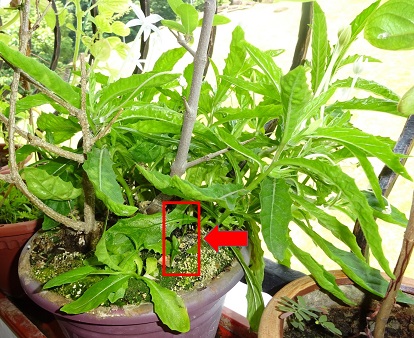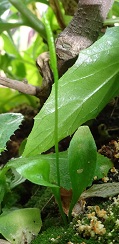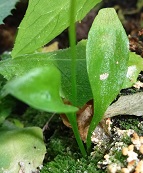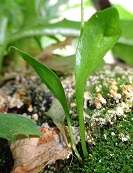| Home | Nature Weekly Index |
28 June 2015 | Tongue Fern in My Pot | Ophioglossum reticulatum |
 Yesterday, I found an interesting fern in one of my pots that prompted me to change the topic that I wanted to share for this week.
Originally, I wanted to write about some sightings on my walk at the park last Sunday. But, I was more excited about finding this
fern. I had not seen it for some years now and never expected it to turn up in my pot.
Yesterday, I found an interesting fern in one of my pots that prompted me to change the topic that I wanted to share for this week.
Originally, I wanted to write about some sightings on my walk at the park last Sunday. But, I was more excited about finding this
fern. I had not seen it for some years now and never expected it to turn up in my pot.

 It was a small lone Tongue Fern that could be easily mistaken to be the young plant of
Hippobroma longiflora (Star of Bethlehem), which was the predominant plants
in that crowded pot. If I had not get close to scrutinize the undergrowth in that pot, I might have missed it altogether. Judging
from the appearance of the fertile spike on the fern, it should have been around for quite a while. To be able to clearly show the
fern in the crowded pot, I had placed a white paper behind the fern. The red arrow and the red box in the picture of the pot
pointed to the location of the fern. It was hardly visible unless one get very close to the pot.
It was a small lone Tongue Fern that could be easily mistaken to be the young plant of
Hippobroma longiflora (Star of Bethlehem), which was the predominant plants
in that crowded pot. If I had not get close to scrutinize the undergrowth in that pot, I might have missed it altogether. Judging
from the appearance of the fertile spike on the fern, it should have been around for quite a while. To be able to clearly show the
fern in the crowded pot, I had placed a white paper behind the fern. The red arrow and the red box in the picture of the pot
pointed to the location of the fern. It was hardly visible unless one get very close to the pot.
The non-fertile leaf (known as trophophore) of my Tongue Fern including the stalk was about 2.5 centimetres (cm) long while the fertile spike (known as sporophore) arising from the mossy soil was about 5 cm in height. The top section of the spike that housed the immature sporangia (spore-containing bodies) was about 1 cm long.


 In the 2009 Singapore Flora checklist, there were 3 species of
Tongue Fern listed, namely Ophioglossum nudicaule, Ophioglossum pendulum and
Ophioglossum reticulatum. Ophioglossum pendulum was
out as this fern usually grows on trees and is much larger in size than the Tongue Fern I saw. According to the
Flora of North America website,
Ophioglossum nudicaule had 5-12 pairs of sporangia. As for Ophioglossum reticulatum, the number of sporangia was
noted to be 20-45 pairs by the
Flora of Zimbabwe website. Though the
fertile spike was still immature, the vaguely visible sporangia appeared to be more than 12 pairs. Based on this feature alone and
knowing that there were only 2 choices left, this fern is likely to be Ophioglossum reticulatum. The ones that I last seen
in 2008 had heart-shaped leaves while this one in my pot had more elongated leaves.
In the 2009 Singapore Flora checklist, there were 3 species of
Tongue Fern listed, namely Ophioglossum nudicaule, Ophioglossum pendulum and
Ophioglossum reticulatum. Ophioglossum pendulum was
out as this fern usually grows on trees and is much larger in size than the Tongue Fern I saw. According to the
Flora of North America website,
Ophioglossum nudicaule had 5-12 pairs of sporangia. As for Ophioglossum reticulatum, the number of sporangia was
noted to be 20-45 pairs by the
Flora of Zimbabwe website. Though the
fertile spike was still immature, the vaguely visible sporangia appeared to be more than 12 pairs. Based on this feature alone and
knowing that there were only 2 choices left, this fern is likely to be Ophioglossum reticulatum. The ones that I last seen
in 2008 had heart-shaped leaves while this one in my pot had more elongated leaves.
This particular pot had been there since March 2011, more than 4 years now. It had stayed that long because I wanted to preserve the Malpighia glabra (Barbados Cherry) growing in that pot.
Update: 24 July 2016
Correction: The fertile spike did not arise from the mossy soil. Instead, the spike was sitting at the end of a stalk that was an extension of the stalk of the sterile leaf. I had did another write up of this fern in my pot in July 2016.